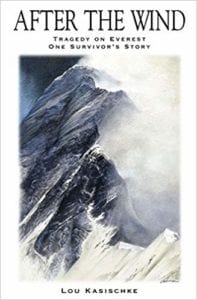
About the Book:
Near the top of Mount Everest, on 10 May 1996, eight climbers died. It was the worst tragedy in the mountain’s history. Lou Kasischke was there. After the Wind tells the harrowing story of what went wrong, as it has never been told before – including why the climbers were so desperately out of time as the rogue storm struck. His personal story, captured in the title AFTER THE WIND, tells about the intense moments near the top. These moments also revealed the love story that saved his life.
In the spring of 1996, Lou Kasischke joined renowned climber Rob Hall’s Mount Everest expedition. When he said goodbye to his wife, Sandy, he knew he faced major physical and mental challenges against rock, snow, ice, avalanches, and extreme high altitude to climb the highest mountain in the world.
What Lou didn’t know was that he also stood at the threshold of a living hell. Six weeks later near the top, things went wrong. Lou and his fellow climbers faced a challenge even greater than the mountain – the internal struggle about what to do when you are close but out of time. There were no second chances. Decisions were made. Some lived. Some died. It was the worst tragedy in Mount Everest history.
Lou wrote his account of the events 16 years ago in the aftermath of the tragedy, but only now is he ready to let it go. He tells two stories. One is about the historic events. His perspective and analysis about what happened and what went wrong have never been told, and his account differs markedly from what others have written. The truth in the story depends on who is telling it.
Lou also tells a very personal story about how he came back home. An inspiring story about where to go for inner strength when facing a tough decision. A story about his wife Sandy’s part in his survival. A story about what he heard, after the wind – the voice of the heart. A love story.
Read an Excerpt:
Featured in Oct/Nov 2015 Issue: Read Global
I was excited and anxious. After almost six weeks, we were on the final push for the summit. Once the decision was made to leave Camp 2 it was a single continuous push. Camp 3 and High Camp would only be brief rest stops on the way to the top of the world.
By my calculation and assumption, we would be on the move for 59 or more hours, with little if any sleep, and little solid food to eat. Sleep deprivation and lack of nutrition, by themselves, magnify the difficulty of all the climbing challenges. Hopefully I could get my body to digest solid food, but I wasn’t counting on it. My body would also have to climb 7,800 vertical feet while hypoxic and while my cell structure was dying from oxygen starvation. Also, in very practical terms, others who had climbed the terrain before told me there was no place to sit down and take a rest. If you wanted to rest, it would be while standing and gasping for air.
If everything did not continue as a go for some reason, it was possible to wait above the altitude at Camp 2 for a limited time before going further, or even return to Camp 2 after an aborted attempt and try again later. This commonly occurred and we were prepared for that possibility. We had the time and resources. But we never talked much about that contingency. Rob was always positive. He said that the idea and priority was to have patience and pull it off the first time and avoid the physical and logistical challenge of a second attempt.
I knew the next 59 hours would be the big hurt. It would be all misery. Suffer and endure.
From After the Wind by Lou Kasischke. Reprinted with permission. All rights reserved.
